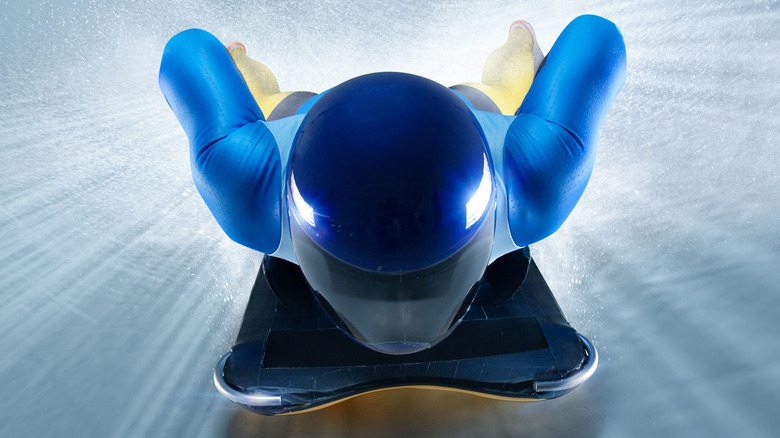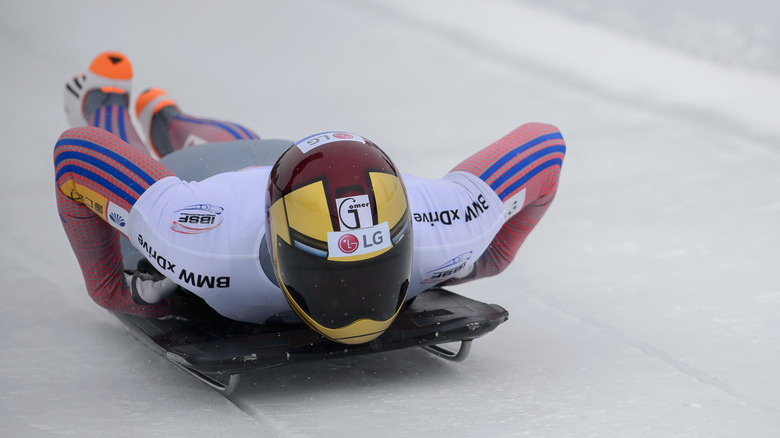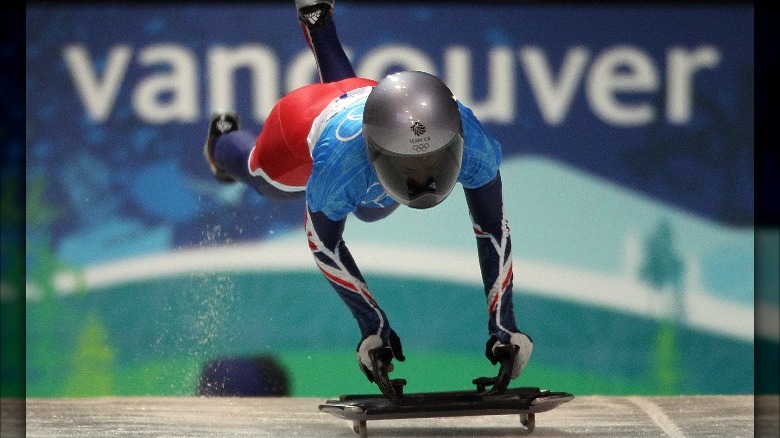What Is The Olympic Sport Of Skeleton And Why Is It Called That?
Imagine barreling down an ice track on a sled headfirst. That's the thrilling and terrifying sensation that skeleton athletes know well. The sport got its start in the 1880s when English soldiers made a track for toboggans in Switzerland. Their sport takes its name not from the potential injuries to one's skeleton, but possibly from a bit of mistranslation, according to the International Bobsleigh and Skeleton Federation (IBSF). In 1892, an Englishman made a new type of metal sled. Some say that this sled looked like a human skeleton, which is where the name comes from. But others believe that "skele" is a mistranslation of "kjaelke," which is the Norwegian word for a type of sled.
No matter the origin of its unusual name, skeleton rose to fame in the 1920s. It officially became an Olympic sport in 1926, and, two years later, Jennison Heaton took home the first gold medal in skeleton at the Winter Games in St. Moritz, Switzerland. The sport reappeared at the 1948 Winter Games, also held in St. Moritz (via the Olympics official site). But for decades after that, the Olympics skipped the skeleton event. The sport had an impressive comeback at the 2002 Winter Olympics in Salt Lake City, Utah, with both a men's and women's competition.
Skeleton racers need lightweight, sturdy gear
As a sport, skeleton requires a very limited amount of equipment. Skeleton athletes wear a race suit that's designed to be aerodynamic to help them speed down the course, according to British Bobsleigh and Skeleton. And given their headfirst traveling position, they also use special helmets that are both lightweight and protective in case of a crash. The athletes have visors for the helmets and may even wear more than one at time, depending on course conditions. On their feet, they wear shoes with spikes, which helps them get traction on the ice at the start of the race. Racers also wear gloves to protect their hands (via the IBSF).
Perhaps the most critical piece of equipment is the sled itself. Skeleton competitors zip down the icy track on their sleds at speeds of close to 100 miles per hour (via Team USA). The sled is made of steel and fiberglass with two steel runners, and it has no brakes, according to the IBSF. Sled length varies from a minimum of 31 inches (80 centimeters) to a maximum of 47 inches (120 centimeters). Even the distance between the two runners is regulated and must be between 13 inches (34 centimeters) and nearly 15 inches (38 centimeters).
How the skeleton event is scored
To win a skeleton competition, the racer has to use a lot of finesse. The competitor starts off holding on the sled's handle and then makes a quick dash and jumps on the sled (via IBSF). The sled has no brakes and no built-in steering method so victory depends on careful shifts in body weight to handle the turns found along the course (via Team USA). The shoulders and legs are especially key in making adjustments in the sled's direction. Oversteering, however, may cause the sled to skid, and understeering leaves the racer at the mercy of the course itself. And this is all managed while the athlete's chin is only about two inches (five centimeters) from the ice below.
At the Olympics, the skeleton event is held over two days with four heats. The winner is determined by who has the lowest combined time after four runs. This is really a sport where every fraction of a second counts. At the 2018 Olympic Games in PyeongChang, the top five women's competitors finished within the same second (via the Olympics). Great Britain's Lizzy Yarnold edged out the other racers for the gold. In the men's race, only two seconds separated gold medal winner Sungbin Yun of Korea from his closest competitor Nikita Tregubov of Russia. Yarnold and Christopher Grotheer of Germany are considered top contenders for the women's and men's skeleton at the 2022 Olympics in Beijing.


